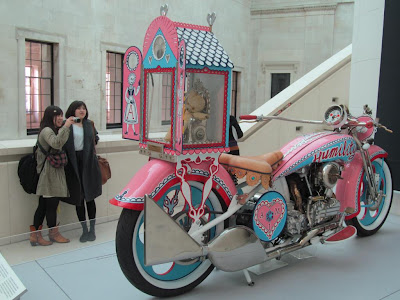 |
| Cindy Sherman at MOMA until June 2012 (with make-up) |
In week 4 we also looked at Cindy Sherman and debated the claim that she is the greatest living female artist. I'm a sceptic and started to think about the competition. As a result I've come up with the following Top 5 female living artists as follows (in no particular order and using the usual criteria of - influence on others, subjective judgement, personal prejudice, etc):
1 - Yoko Ono - Hugely influential artist working in a number of media. Her involvement with John Lennon led many people to become aware of and investigate modern art (me included).
 |
| Jenny Savile |
2 - Jenny Saville - Real painter of women in the tradition of Francis Bacon and Lucian Freud (and Picasso and Rubens?) with a distinctive and visceral style.
 |
| Paula Rego - Betrothal from Hogarth tryptich |
3 - Paula Rego - An artist who tells stories using a variety of different, but recognisable, styles, normally in pastels. Her images are often animalistic - a feminist artist who produces unsettling work. (See this facebook page for further Rego images - thanks Ernesto).
 |
| Tracey Emin - Exorcism of the Last Painting I Ever Made |
4 - Tracey Emin - A member of the YBAs, she has transcended this and shown herself capable of producing a range of impressive work including installations, paintings, neon, and use of fabrics (and more) which is largely autobiographical.
 |
| Bridget Riley |
Finally, at joint No.5 (cheating here) - Bridget Riley - the queen of Op Art, who has consistently taken the form in new directions from the 1960s to the present time; and Elizabeth Fritsch - a studio potter whose work is perfection (and is often influenced by music, painting, and architecture).
 |
| Pots by Elizabeth Fritsch |
Runners-up: Barbara Kruger, Jenny Holzer, Rachel Whiteread, Nan Goldin, Marina Abramović ... ?
In the final week of the 'isms' course we're getting an early look at The Perfect Nude exhibition, which runs from 29 March to 12 May at the Phoenix. A hundred artists have been invited to make paintings on the theme of The Perfect Nude. The aim is to "create a rich network of images that will establish a context for representation of the body in contemporary painting". Should be interesting.
The picture above is not from the exhibition, of course - it's an output from the life class I attended last year - far from Perfect, but I like to think that the subject would hit it off with the guy in the flyer above ...
 |
| Modern Art - Is this how it happened? |
Finally, if you're looking for an online Modern Art History course, why not take a look at this one which does an excellent job of covering the development of art from the late 1800s to the 1960s, with plenty of examples and lecture slides. You can also read further in the book chapters referred to throughout (History of Modern Art by Arnason - a big and expensive book, but more reasonably priced secondhand copies of older editions are plentiful).











































